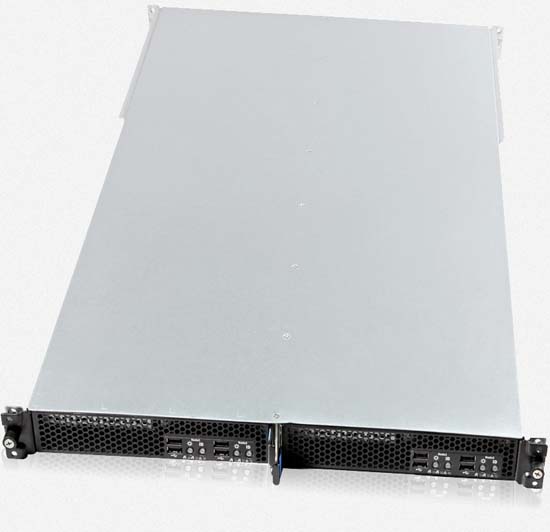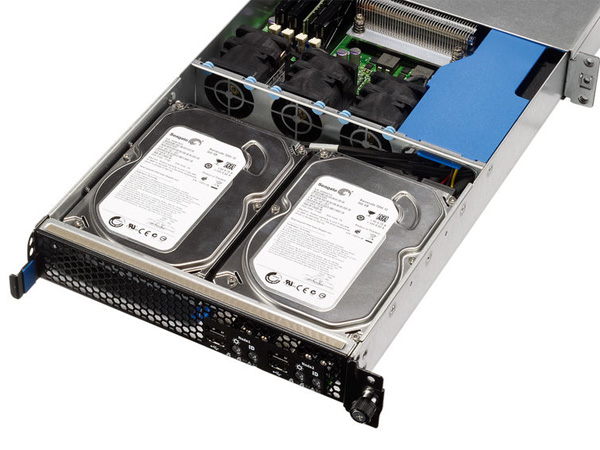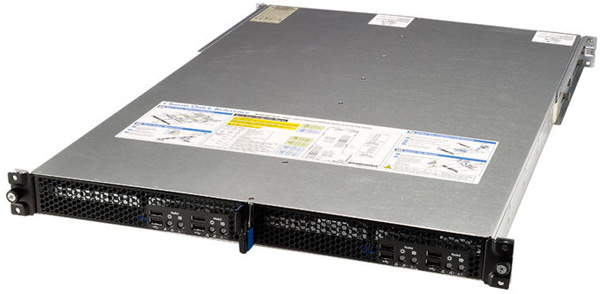 All orders Built, Shipped & Supported from within the European Union
All orders Built, Shipped & Supported from within the European Union

 All orders Built, Shipped & Supported from within the European Union
All orders Built, Shipped & Supported from within the European Union

"Broadberry proves four into one will go as the X34-Q104 delivers a high-density compute node package at a low price
Dave Mitchell 19 Jan 2011 |

Configure From €2,646.42 or Configure


Server manufacturers have been getting ever more innovative in the quest for higher compute node density, but Broadberry has taken things to a new level. It's managed the remarkable feat of squeezing four independent servers into a low-profile 1U rack chassis.
The X34-Q104 comes courtesy of Intel's latest Server System SR1640TH platform. Previously Intel's rack server solutions have been functional but uninspiring in the design department.
The four server nodes are presented as two separate motherboards, each fitted in independently powered trays. Both motherboards have two processor sockets supporting Xeon 3400 processors, but have been designed to present each one as a separate server.
The chassis works purely as a shell for the two trays. The only components inside are two 450W cold-swap power supplies, which the trays mate with when inserted from the front.
The design of the tray is impressive. Components are neatly laid out down their length, with hardly a wire or cable out of place to mar the symmetry. The front of each tray houses two hard disks, and even here Intel has reduced cabling requirements by placing the SATA and power interfaces at the front.

Broadberry offers a good choice of storage options. It supplied the left-hand tray with a pair of 500GB Seagate Barracuda SATA drives and the right-hand tray with two 80GB Intel SSDs. The price for the review system includes all these drives, but Broadberry can supply the system with four 80GB SSDs for £2,550 or four 500GB SATA drives for £2,180 exc VAT.
The nodes get a single processor socket each, with the review system sporting a quartet of 2.4GHz X3430 Xeons. These offer the lowest core density of all the 3400 Xeons as they don't support Hyper-Threading.
Each processor is equipped with four DIMM sockets, with the 3420 chipset supporting a maximum of 32GB of 1,333MHz DDR3 memory. The chipset also has an embedded RAID controller that supports stripes, mirrors and RAID5 arrays, although with only one drive per node this is academic.
The one feature we didn't like was the basic Matrox G200 video chip on each node. These have only 32MB of video memory and support a maximum resolution of 1,024 x 768, which is a real pain for local management.
The motherboards may not look like two independent nodes, but a glance at the back gives the game away. The rear panel for each tray has a complete set of ports for each node, which comprise monitor, dual Gigabit, dual USB 2 and remote management.
The tray's front panel has power and ID buttons for each node, along with LEDs for network activity and warnings, plus two more USB ports. Having four USB ports per node means you can leave the keyboard and mouse plugged in and still use a USB stick or other storage device.
Each tray has its own 450W cold-swap power supply inside the chassis. When you remove a tray the supply stays put, but if you need to replace it the unit can be easily withdrawn from the rear.
Our tests found the server to be miserly when it comes to power. As we brought each node online we took measurements with them running in idle and with SiSoft Sandra pushing all cores on each one to near maximum.

In idle we saw one, two, three and four nodes draw 56W, 72W, 110W and 138W, and under pressure these figures peaked at 116W, 188W, 282W and 370W. The nodes do have fairly basic specifications, but a maximum draw of only 92W per server under very heavy load is not to be sniffed at.
The X34-Q104 is also remarkably quiet. Each tray has three dual-rotor cold-swap fans at the front, and during normal operations the server is quiet enough to sit on a desk. The fans increased their speed when we ran the SiSoft load test, but only briefly, and even then noise levels weren't a concern.
Each node has an integrated BMC and the bundled Intel Active System Console provides basic local server monitoring. The optional RMM3 Lite-V modules activate web browser access to all power controls, plus extensive views of all sensor data. KVM-over-IP remote control comes as standard and you can define virtual floppy and optical media for the node to use.
The CyberServe X34-Q104 is one of the best-built and designed systems we've seen from Intel's Server Systems family and is suited to a range of tasks, including hosting and web serverfarms. Power consumption and noise levels are commendably low, and with each node in this system costing less than £600 it's good value too.